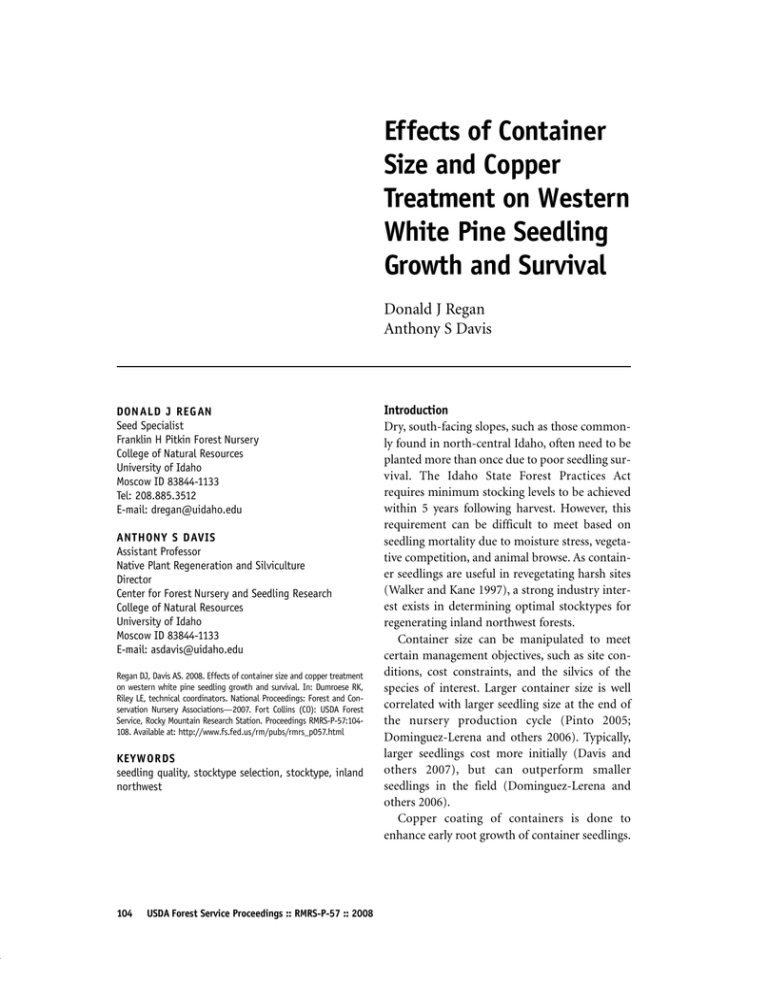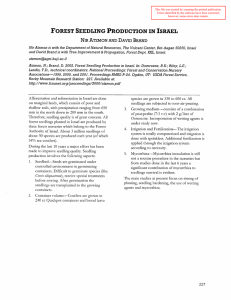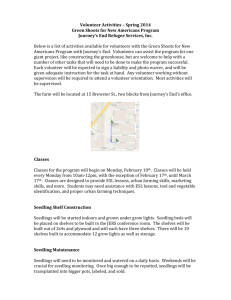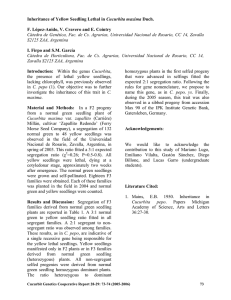Effects of Container Size and Copper Treatment on Western White Pine Seedling
advertisement

nnp interior 11.21 1/9/09 9:19 AM Page 104 Effects of Container Size and Copper Treatment on Western White Pine Seedling Growth and Survival Donald J Regan Anthony S Davis DON ALD J REG AN Seed Specialist Franklin H Pitkin Forest Nursery College of Natural Resources University of Idaho Moscow ID 83844-1133 Tel: 208.885.3512 E-mail: dregan@uidaho.edu ANTHONY S DAVIS Assistant Professor Native Plant Regeneration and Silviculture Director Center for Forest Nursery and Seedling Research College of Natural Resources University of Idaho Moscow ID 83844-1133 E-mail: asdavis@uidaho.edu Regan DJ, Davis AS. 2008. Effects of container size and copper treatment on western white pine seedling growth and survival. In: Dumroese RK, Riley LE, technical coordinators. National Proceedings: Forest and Conservation Nursery Associations—2007. Fort Collins (CO): USDA Forest Service, Rocky Mountain Research Station. Proceedings RMRS-P-57:104108. Available at: http://www.fs.fed.us/rm/pubs/rmrs_p057.html KEYWORDS seedling quality, stocktype selection, stocktype, inland northwest 104 USDA Forest Service Proceedings :: RMRS-P-57 :: 2008 Introduction Dry, south-facing slopes, such as those commonly found in north-central Idaho, often need to be planted more than once due to poor seedling survival. The Idaho State Forest Practices Act requires minimum stocking levels to be achieved within 5 years following harvest. However, this requirement can be difficult to meet based on seedling mortality due to moisture stress, vegetative competition, and animal browse. As container seedlings are useful in revegetating harsh sites (Walker and Kane 1997), a strong industry interest exists in determining optimal stocktypes for regenerating inland northwest forests. Container size can be manipulated to meet certain management objectives, such as site conditions, cost constraints, and the silvics of the species of interest. Larger container size is well correlated with larger seedling size at the end of the nursery production cycle (Pinto 2005; Dominguez-Lerena and others 2006). Typically, larger seedlings cost more initially (Davis and others 2007), but can outperform smaller seedlings in the field (Dominguez-Lerena and others 2006). Copper coating of containers is done to enhance early root growth of container seedlings. nnp interior 11.21 11/24/08 9:35 PM Page 105 Copper is toxic to roots, and roots will self-prune on contact with the copper-treated cell wall. After outplanting, these root tips will grow more lateral roots, particularly in the upper profile of the root plug (Burdett and others 1983; Wenny and Woollen 1989; Dumroese 2000; Campbell and others 2006). This improved lateral root development can result in altered, and potentially improved, seedling water and nutrient acquisition (Burdett and others 1983). Our study objective was to compare survival and growth of outplanted western white pine (Pinus monticola) seedlings, grown in 2 sizes of containers, with and without copper coating. We hypothesized that seedlings grown with copper treatment would outperform non-copper seedlings based on better root penetration, which facilitates water and nutrient uptake, and that seedlings that were larger at outplanting would maintain their size difference over time. Methods Western white pine seedlings were grown in 2004 under operational practices at the University of Idaho Franklin H Pitkin Forest Nursery (Moscow, Idaho) in 2 sizes (120/80 and 91/130) of Copperblock™ and Styroblock™ containers (Beaver Plastics, Edmonton, Alberta, Canada). Copperblock™ containers are coated with copper oxychloride on the inside walls, serving as a rootpruning mechanism. The 120/80 containers have a growing density of 120 seedlings per container and a cavity volume of 80 ml (5 in3), while 91/130 containers have a growing density of 91 seedlings per container and a cavity volume of 130 ml (8 in3). At lifting (December 2004), a subsample of seedlings was oven-dried for biomass assessment. The remaining seedlings were placed in refrigerated storage until spring, at which time they were outplanted. An experimental site was chosen near Elk River, Idaho. Four replications were established as a randomized complete block design with 20 seedlings per treatment replication. The study was a 2 x 2 factorial (copper coating x container size). One replication was dropped due to excessive damage by ungulates. Survival, height, and root collar diameter were measured after outplanting, and at the end of each growing season (2005 and 2006). Data were analyzed with 2-way analysis of variance using SAS software (SAS Institute Incorporated, Cary, North Carolina), and significant differences at α = 0.05 highlighted using LSMEANS. Results Container size had a significant influence on initial seedling root biomass (P = 0.0422), shoot biomass (P = 0.0026), and total biomass (P = 0.0091), with seedlings from larger cavities having greater biomass than those from smaller cavities (Table 1). Similarly, seedlings grown in the Table 1. Initial biomass of seedlings. Letters indicate significant differences (α = 0.05). Container Size Type Root ± SE Dry weight (g) Shoot ± SE Seedling ± SE 120/80 Styroblock® 1.27 ± 0.16 a 1.34 ± 0.13 a 2.61 ± 0.27 a Copperblock® 1.21 ± 0.16 a 1.37 ± 0.20 a 2.80 ± 0.35 a Styroblock® 1.80 ± 0.27 b 2.60 ± 0.37 b 4.40 ± 0.63 b Copperblock® 2.00 ± 0.17 b 2.88 ± 0.22 b 4.88 ± 0.38 b 91/130 USDA Forest Service Proceedings :: RMRS-P-57 :: 2008 105 nnp interior 11.21 11/24/08 9:35 PM Page 106 Figure 1. Seedling height: initial (top), 2-year growth (middle), and total (bottom). Main effect of container size was significant for all 3, and copper treatment significant for only initial height. Letters and * indicate significant differences (α = 0.05). 106 USDA Forest Service Proceedings :: RMRS-P-57 :: 2008 Figure 2. Seedling root collar diameter: initial (top), 2-year growth (middle), and total (bottom). Main effect of container size was significant for all 3. * indicates significant difference (α = 0.05). nnp interior 11.21 11/24/08 9:35 PM Page 107 Table 2. Initial shoot-to-root ratios of seedlings. Letters indicate significant differences (α = 0.05). Container Size Type Shoot:root ± SE 120/80 Styroblock® Copperblock® 1.10 ± 0.07 a 1.14 ± 0.08 a 91/130 Styroblock® Copperblock® 1.48 ± 0.06 b 1.45 ± 0.05 b larger (91/130) cavities had greater shoot-to-root ratios (P = 0.0008, Table 2) than those grown in 120/80 containers. Treatment with copper had no significant effect on initial biomass (P = 0.5900). At outplanting, seedlings grown in copper-treated containers were shorter (P = 0.0164) than those grown in regular containers, but no difference was identified for initial root collar diameter (P = 0.1354). Cavity size had a significant effect on both initial height (P = 0.0018) and root collar diameter (P = 0.0004), with seedlings grown in 91/130 containers being larger than those in 120/80 containers (Figures 1 and 2). Seedling survival was not influenced by treatments (P = 0.9636), and was approximately 90% across all treatments. Height growth (Figure 1) and root collar diameter growth (Figure 2) were significantly greater in larger cavities (P = 0.0215 and P = 0.0012, respectively), but not influenced by copper treatment (P = 0.3095 and 0.8359, respectively). At the end of 2 growing seasons, height (P = 0.0069; Figure 1) and root collar diameter (P = 0.0003; Figure 2) were significantly greater in 91/130 containers than in 120/80 containers. Discussion and Future Directions Seedlings grown in larger containers grew more in height and root collar diameter than seedlings in smaller containers after 2 growing seasons, in addition to being larger initially. This corresponds to expected behavior, given knowledge of plant use of growing space and resource acquisition, as well as existing evidence (DominguezLerena and others 2006). However, nursery cultural practices and early stand silviculture must be treated as dynamic processes to ensure proper seedling production. Furthermore, increasing shoot size may not be without detriment to root morphology, as identified in a study of longleaf pine (Pinus palustris) by South and others (2005). Copper treatment had no effect on seedling growth after 2 growing seasons, despite some initial differences in seedling height. Therefore, treatment of container seedling cavity walls with copper was not effective at addressing initial concerns over seedling performance on this site. This corresponds with the findings of Wenny and others (1988) investigating western white pine. However, given known variability in growth in other species, such as lodgepole pine (Pinus contorta), where results have found both improvement (Burdett and others 1983) and no difference (Campbell and others 2006) in seedling growth after outplanting, attention must be paid to species, site, and environmental conditions at time of establishment. The potential for added mechanical stability (Burdett and others 1983) further highlights a possible long-term benefit of copper-coated containers. Finally, longer term assessment may be warranted, as height growth was not significantly impacted by copper treatment until year 4 of the study described by Burdett and others (1983). However, Wenny (1988) did not find any difference in Douglas-fir (Pseudotsuga menziesii), western white pine, and ponderosa pine (Pinus ponderosa) seedling growth after 3 field growing seasons. Our intention is to continue to maintain and monitor these plots. Thus, they may be thinned to minimize within-treatment competition. Furthermore, in addition to continued assessment of seedling morphology, it is intended that economic analysis of treatments will be performed after seedlings reach free-to-grow status. USDA Forest Service Proceedings :: RMRS-P-57 :: 2008 107 nnp interior 11.21 11/24/08 9:35 PM Page 108 Acknowledgments This study was funded by Potlatch Corporation and the University of Idaho Center for Forest Nursery and Seedling Research. Field and technical support was provided by Dan Miller, Abbie Acuff, John Mandzak, Dave Wenny, and Raini Rippy. South DB, Harris SW, Barnett JP, Hainds MJ, Gjerstad DH. 2005. Effect of container type and seedling size on survival and early height growth of Pinus palustris seedlings in Alabama, U.S.A. Forest Ecology and Management 204:385-398. Walker RF, Kane LM. 1997. Containerized Jeffery pine growth and nutrient uptake in response to mycorrhizal inoculation References Burdett AN, Simpson DG, Thompson CF. 1983. Root development and plantation establishment success. Plant and Soil 71:103-110. Campbell DB, Kiiskila S, Philip LJ, Zwiazek JJ, Jones MD. and controlled release fertilization. Western Journal of Applied Forestry 12:33-40. Wenny DL, Woollen RL. 1989. Chemical root pruning technique improves the root system morphology of containerized seedlings. Western Journal of Applied Forestry 4:15-17. 2006. Effects of forest floor planting and stock type on Wenny DL, Liu Y, Dumroese RK, Osborne HL. 1988. First year growth and root emergence of Pinus contorta seedlings in field growth of chemically pruned containerized seedlings. a cold northern cutblock. New Forests 32:145-162. New Forests 2:111-118. Davis AS, Brusven ADL, Dumroese RK, Wenny DL. 2007. A Wenny DL. 1988. Growth of chemically root-pruned seedlings guide to seedling selection. Moscow (ID): University of in the greenhouse and the field. In: Landis TD, technical Idaho. Miscellaneous Publication Number 18. 40 p. coordinator. Proceedings, combined meeting of the west- Dominguez-Lerena S, Herrero Sierra N, Carrasco Manzano I, ern forest nursery associations; 1988 August 8-11; Vernon, Ocana Bueno L, Penuelas Rubira JL, Mexal JG. 2006. Con- British Columbia. Ft. Collins (CO): USDA Forest Service, tainer characteristics influence Pinus pinea seedling devel- Rocky Mountain Forest and Range Experiment Station. opment in the nursery and field. Forest Ecology and Man- General Technical Report RM-167. agement 221:63-71. Dumroese RK. 2000. Changes in interior Douglas-fir root development in containers after copper and auxin treatments. Western Journal of Applied Forestry 15:213-216. Pinto JR. 2005. Container and physiological status comparisons of Pinus ponderosa seedlings [MSc thesis]. Moscow (ID): University of Idaho. 32 p. 108 USDA Forest Service Proceedings :: RMRS-P-57 :: 2008






